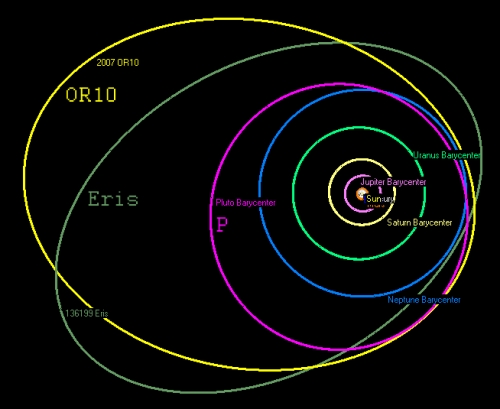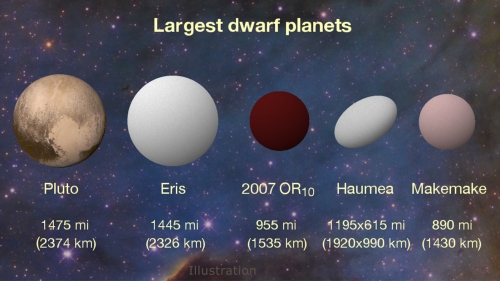Although we always think of Kepler — and its successor mission K2 — as an exoplanet observatory, the spacecraft has also been put to work on objects much closer to home. Enter 2007 OR10, a dwarf planet that is currently about twice as distant from the Sun as Pluto. The Kepler instrument is, of course, fine-tuned for spotting the minute variations in light caused when a planet passes in front of a distant star. But that makes it an excellent tool for studying 2007 OR10, whose dim light and red color have proved difficult to parse by other instruments.
Kepler, though, is not alone in this work. What we see is a useful collaboration between it and the European Space Agency’s Herschel Space Observatory. Using archival data from the latter, researchers have been able to measure both the fraction of starlight absorbed and later re-radiated as heat (via Herschel) as well as the fraction of starlight reflected from 2007 OR10 via Kepler. K2, sensitive to minute changes in brightness, was able to show that the object is one of the slowest rotating objects in the Solar System, taking about 45 hours to complete a revolution.

Image: The orbit of 2007 OR10 compared to the orbit of Eris, Pluto, and the outer planets. Credit: kheider [GPL (http://www.gnu.org/licenses/gpl.html)], via Wikimedia Commons.
Coupled with the Herschel data in the infrared, we’ve now established a more accurate measurement of 2007 OR10’s diameter than Herschel could provide on its own. The dwarf planet has a diameter of 1535 kilometers, some 250 kilometers greater than previously thought. That makes the surface darker as well, given that the same amount of light is being reflected by a larger object. The paper on this work discusses what this implies about the surface:
The red color of 2007 OR10 is likely to be due to the [retention] of methane, as it was proposed by Brown, Burgasser & Fraser (2011). In Fig. 1 in Brown, Burgasser & Fraser (2011), 2007 OR10 is nearly placed on the retention lines of CH4, CO and N2. The larger diameter derived in our paper places this dwarf planet further inside the volatile retaining domain, making the explanation of the observed spectrum more feasible.
The newly determined larger size of the dwarf planet, then, makes it more likely that the object can retain these volatile ices than if it had been smaller. The size, in fact, makes 2007 OR10 the third largest dwarf planet known after Pluto and Eris, just ahead of Makemake.

Image: New K2 results peg 2007 OR10 as the largest unnamed body in our solar system and the third largest of the current roster of about half a dozen dwarf planets. The dwarf planet Haumea has an oblong shape that is wider on its long axis than 2007 OR10, but its overall volume is smaller. Credits: Konkoly Observatory/András Pál, Hungarian Astronomical Association/Iván Éder, NASA/JHUAPL/SwRI.
This isn’t the first time K2 has been involved with objects within the Solar System. Its previous targets have included the objects (278361) 2007 JJ43, 2002 GV31 and Neptune’s moon Nereid. Now, at 2007 OR10, we’re seeing variations in rotational brightness that are intriguing for their suggestion of variations in surface albedo. Here I can’t help recalling New Horizons and the way we went from faint indications of surface features during the long approach, to the close-up clarification of numerous kinds of terrain. How long will it be before we can repeat that feat with another outer system object like this one?
The paper is Pál et al., “Large size and slow rotation of the trans-Neptunian object (225088) 2007 OR10 discovered from Herschel and K2 observations,” Astronomical Journal Vol. 151, No. 5 (2016). Abstract / preprint.



Just a coincidence that Eris, OR10 and Pluto all have orbits that come close to Uranus and at about the same general location?
Just FYI, but the orbits of all three approach Neptune’s orbit, not Uranus’s.
No idea why I wrote Uranus. Must be on my mind for some reason. ( I just watched “Voyage to the Seventh Planet”. maybe that was the source).
If this is one of the Top 20 objects in the Solar System, it really needs a name.
It was nicknamed “Snow White”, but this name doesn’t suit anymore (except if the IAU appreciates ironic names). Probably “Little Red Riding Hood” would be more appropriate, although a little bit too long.
I suggest ‘Rooibos’, because its colour makes me think of this kind of red tea.
‘Carmine’ could also be suitable as it is both a given name and a deep reddish pigment.
“Carmine” seems like a good name!
One of the repeated lessons of solar system exploration is that ice worlds are full of unexpected surprises. Unfortunately it’s probably going to be a long time before we get another mission out to the Kuiper Belt, and the ice giant planets are overdue for a second visit.
Isnt it about time this significant TNO got an official name from the IAU?
P
Nope – for 10 years the naming right belongs to the discoverers, in this case, Meg Schwamb, Mike Brown and David Rabinowitz, and then it will be open for everyone. The IAU only evaluates the proposed names. Mike Brown tweeted that:
“We’ll get around to it. Promise. Really. Some day soon. Honest.”
and
“People: we’re not going to name 2007 OR10 after the Red God in Game of Thrones. I haven’t even finished the final season of Mad Men yet.”
A shame the orbits can’t be displayed in 3D. Although Pluto crosses Neptune’s orbit in a 2D display, since both bodies are in different resonances and different planes, Pluto-Neptune collisions won’t happen. Is it clear for Eris and OR10 as to whether they could ever have close encounters with Pluto or Neptune? The prospect of such huge bodies becoming orbitally destabilised and auguring in to the inner solar system would not be one to be relished!
Try this NASA software :)
Just cut and paste the name into the search field and change orbits, add planets and so on then you can advance in yearly increments to see if they come close to each other, it appears not for object.
Tell me how you get on.
http://ssd.jpl.nasa.gov/sbdb.cgi?sstr=2007+OR10&orb=1
opps it does go close to it but not at the same time, must have looked at Neptunes orbit.